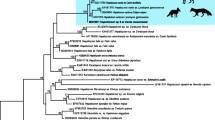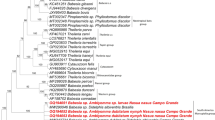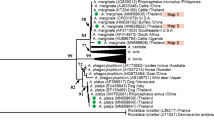Abstract
The objective of our study was identification and molecular characterization of piroplasms and rickettsias occurring in brown (Parahyaena brunnea) and spotted hyaenas (Crocuta crocuta) from various localities in Namibia and South Africa. Whole blood (n = 59) and skin (n = 3) specimens from brown (n = 15) and spotted hyaenas (n = 47) were screened for the presence of Babesia, Theileria, Ehrlichia and Anaplasma species using the reverse line blot (RLB) hybridization technique. PCR products of 52/62 (83.9%) of the specimens hybridized only with the Theileria/Babesia genus-specific probes and not with any of the species-specific probes, suggesting the presence of a novel species or variant of a species. No Ehrlichia and/or Anaplasma species DNA could be detected. A parasite 18S ribosomal RNA gene of brown (n = 3) and spotted hyaena (n = 6) specimens was subsequently amplified and cloned, and the recombinants were sequenced. Homologous sequence searches of databases indicated that the obtained sequences were most closely related to Babesia lengau, originally described from cheetahs (Acinonyx jubatus). Observed sequence similarities were subsequently confirmed by phylogenetic analyses which showed that the obtained hyaena sequences formed a monophyletic group with B. lengau, B abesia conradae and sequences previously isolated from humans and wildlife in the western USA. Within the B. lengau clade, the obtained sequences and the published B. lengau sequences were grouped into six distinct groups, of which groups I to V represented novel B. lengau genotypes and/or gene variants. We suggest that these genotypes cannot be classified as new Babesia species, but rather as variants of B. lengau. This is the first report of occurrence of piroplasms in brown hyaenas.


Similar content being viewed by others
References
Alexander KA, Kat PW, Frank LG, Holekamp KE, Smale L, House C, Appel MJG (1995) Evidence of canine distemper virus infection among free-ranging spotted hyaenas in the Masai Mara, Kenya. J Zoo Wildl Med 26:201–206
Alexander KA, McNutt JW, Briggs MB, Standers PE, Funston P, Hemson G, Keet D, van Vuuren M (2010) Multi-host pathogens and carnivore management in southern Africa. Comparative Immunology, Microbiology and Infectious Diseases 33(3):249–265
Allsopp MT, Allsopp BA (2006) Molecular sequence evidence for the reclassification of some Babesia species. Ann N Y Acad Sci 1081:509–517
Altschul SF, Gish W, Miller W, Meyers EW, Lipman DJ (1990) Basic local alignment search tool. J Mol Biol 215:403–410
Apanaskevich DA, Horak IG, Camicas J-L (2007) Redescription of Haemaphysalis (Rhipistoma) elliptica (Koch, 1844), an old taxon of the Haemaphysalis (Rhipistoma) leachi group from East and southern Africa, and of Haemaphysalis (Rhipistoma) leachi (Audouin, 1826) (Ixodida, Ixodidae). Onderstepoort J Vet Res 74:181–208
Bekker CP, De Vos S, Taoufik A, Sparagano OA, Jongejan F (2002) Simultaneous detection of Anaplasma and Ehrlichia species in ruminants and detection of Ehrlichia ruminantium in Amblyomma variegatum ticks by reverse line blot hybridization. Vet Microbiol 89:223–238
Bohm T, Höner OR (2015) Crocuta crocuta. The IUCN Red List of Threatened Species 2015: e.T5674A45194782. http://dx.doi.org/10.2305/IUCN.UK.2015-2.RLTS.T5674A45194782.en. Downloaded on 16 August 2016
Bosman A-M, Oosthuizen MC, Pierce MA, Venter EH, Penzhorn BL (2010) Babesia lengau sp. nov., a novel Babesia species in cheetah (Acinonyx jubatus, Schreber, 1975) populations in South Africa. J Clin Microbiol 48:2703–2708
Bosman A-M, Oosthuizen MC, Venter EH, Steyl JCA, Gous TA, Penzhorn BL (2013) Babesia lengau associated with cerebral and haemolytic babesiosis in two domestic cats. Parasit Vectors 6:128. doi:10.1186/1756-3305-6-128
Bosman A-M, Venter EH, Penzhorn BL, Bosman AM, Venter EH, Penzhorn BL (2007) Occurrence of Babesia felis and Babesia leo in various wild felid species and domestic cats in Southern Africa, based on reverse line blot analysis. Veterinary Parasitology 144(1–2):33–38
Collins NE, Allsopp BA (1999) Theileria parva ribosomal internal transcribed spacer sequences exhibit extensive polymorphysims and mosaic evolution; application to the characterization of parasites from cattle and buffalo. Parasitology 181:541–551
Conrad PA, Kjemtrup AM, Carreno RA, Thoford J, Wainwright K, Eberhard M, Quick R, Telford SR III, Herwaldt BL (2006) Description of Babesia duncani n. sp. (Apicomplexa: Babesiidae) from humans and its differentiation from other piroplasms. Int J Parasitol 36:779–789
Felsenstein J (1985) Confidence limits on phylogenies: an approach using the bootstrap. Evolution 39:783–791
Gubbels JM, De Vos AP, Van Der Weide M, Viseras J, Schouls LM, De Vries E, Jongejan F (1999) Simultaneous detection of bovine Theileria and Babesia species by reverse line blot hybridization. J Clin Microbiol 37:1782–1789
Hall TA (1999) BioEdit: a user-friendly biological sequence alignment editor and analysis program for Windows 95/98/NT. Nucleic Acids Symp Ser 41:95–98
Horak IG, Braack LEO, Fourie LJ, Walker JB (2000) Parasites of domestic and wild animals in South Africa. XXXVIII. Ixodid ticks collected from 23 wild carnivore species. Onderstepoort J Vet Res 67:239–250
Giadinis ND, Chochlakis D, Kritsepi-Konstantinou M, Makridaki E, Tselentis Y, Kostopoulou D, Karatzias H, Psaroulaki A (2012) Haemolytic disease in sheep attributed to a -like organism. Veterinary Record 170(6):155.2–155
Jukes TH, Cantor CR (1969) Evolution of protein molecules. In: Munro HN (ed) Mammalian protein metabolism, vol 13. Academic Press, New York, pp. 21–32
Kimura M (1980) A simple method for estimating evolutionary rates of base substitutions through comparative studies of nucleotide sequences. J Mol Evol 16:111–120
Kjemtrup AM, Conrad PA (2006) A review of the small canine piroplasms from California: Babesia conradae in the literature. Vet Parasitol 138:112–117
Kjemtrup AM, Thomford J, Robinson T, Conrad PA (2000) Phylogenetic relationships of human and wildlife piroplasm isolates in the western United States inferred from the 18S nuclear small subunit RNA gene. Parasitol 120:487–493
Kumar S, Stecher G, Tamura K (2016) Molecular Evolutionary Genetics Analysis version 7.0. for bigger datasets. Mol Biol Evol 33:1870–1874
Leclaire S, Menard S, Berry A (2015) Molecular characterization of Babesia and Cytauxzoon species in wild South African meerkats. Parasitology 142:543–548
Nagore D, García-Sanmartín J, García-Pérez AL, Juste RA, Hurtado A (2004) Detection and identification of equine Theileria and Babesia species by reverse line blotting: epidemiological survey and phylogenetic analysis. Vet Parasitol 123:41–54
Nijhof A, Penzhorn BL, Lynen G, Mollel JO, Bekker C, Jongejan F (2003) Babesia bicornis sp. n. and Theileria bicornis sp. n.: tick-borne parasites associated with mortality in the black rhinoceros (Diceros bicornis). J Clin Microbiol 41:2249–2254
Nijhof AM, Pillay V, Steyl J, Prozesky L, Stoltsz WH, Lawrence JA, Penzhorn BL, Jongejan F (2005) Molecular characterization of Theileria species associated with mortality in four species of African antelopes. J Clin Microbiol 43:5907–5911
Oosthuizen MC, Zweygardt E, Collins NE, Troskie MT, Penzhorn BL (2008) Identification of a novel Babesia sp. from sable antelope (Hippotragus niger, Harris 1838). Vet Parasitol 163:39–46
Peirce MA, Anderson MD, Penzhorn BL (2001) Piroplasmosis in the aardwolf (Proteles cristatus). Vet Rec 149:561–562
Penzhorn BL (2006) Babesiosis of wild carnivores and ungulates. Vet Parasitol 138:11–21
Saitou N, Nei M (1987) The neighbor-joining method: a new method for reconstructing phylogenetic trees. Mol Biol Evol 4:406–425
Schnittger L, Rodriguez AE, Florin-Christensen M, Morrison DA (2012) Babesia: a world emerging. Inf Genet Evol 12:1788–1809
Staden R, Beal KF, Bonfield JK (2000) The Staden Package, 1998. In: Misener S, Krawetz SA (eds) Methods in molecular biology, vol 132. Humana Press, Totowa, NJ, pp. 115–130
Thompson JD, Gibson TJ, Plewniak F, Jeanmougin F, Higgins DG (1997) The CLUSTAL_X windows interface: flexible strategies for multiple sequence alignment aided by quality analysis tools. Nucl Acids Res 25:4876–4882
Van Den Berghe L (1937) Un piroplasmide nouveau, Nuttalia alberti n. sp. chez une hyène du Parc National Albert (Congo Belge). Bull Soc Pathol Exot 30:271–272
Van Den Berghe L (1942) Enquête Parasitologique. I. Parasites du sang des vertébrés. Exploration du Parc National Albert en du Parc de la Kagera. Fascicule 1. Institut des Parcs Nationaux de Congo Belge, Brussels, 15 pp.
Wiesel I (2015) Parahyaena brunnea. The IUCN Red List of Threatened Species 2015: e.T10276A82344448. http://dx.doi.org/10.2305/IUCN.UK.2015-4.RLTS.T10276A82344448.en. Downloaded on 16 August 2016
Williams BM, Berentsen A, Shock BC, Teixera M, Dunbar MR, Becker MS, Yabsley MJ (2014) Prevalence and diversity of Babesia, Hepatozoon, Ehrlichia and Bartonella in wild and domestic carnivores from Zambia, Africa. Parasitol Res 113:911–918
Acknowledgements
This research was supported financially by the National Research Foundation (NRF), South Africa (grant no 95836 to BLP and grant no 76529 to MCO). Specimens were obtained from (i) the South African National Parks (SANParks) Biobank, Skukuza, and (ii) the NRF Biobank at the National Zoological Gardens, Pretoria.
Author information
Authors and Affiliations
Corresponding author
Ethics declarations
Conflict of interest
The authors declare that they have no conflict of interest.
Ethical approval
All applicable international, national and/or institutional guidelines for the care and use of animals were followed. This study (V058/11) was approved by the Research Committee of the Faculty of Veterinary Science and the Animal Use and Care Committee of the University of Pretoria.
Rights and permissions
About this article
Cite this article
Burroughs, R.E., Penzhorn, B.L., Wiesel, I. et al. Piroplasms in brown hyaenas (Parahyaena brunnea) and spotted hyaenas (Crocuta crocuta) in Namibia and South Africa are closely related to Babesia lengau . Parasitol Res 116, 685–692 (2017). https://doi.org/10.1007/s00436-016-5334-5
Received:
Accepted:
Published:
Issue Date:
DOI: https://doi.org/10.1007/s00436-016-5334-5




